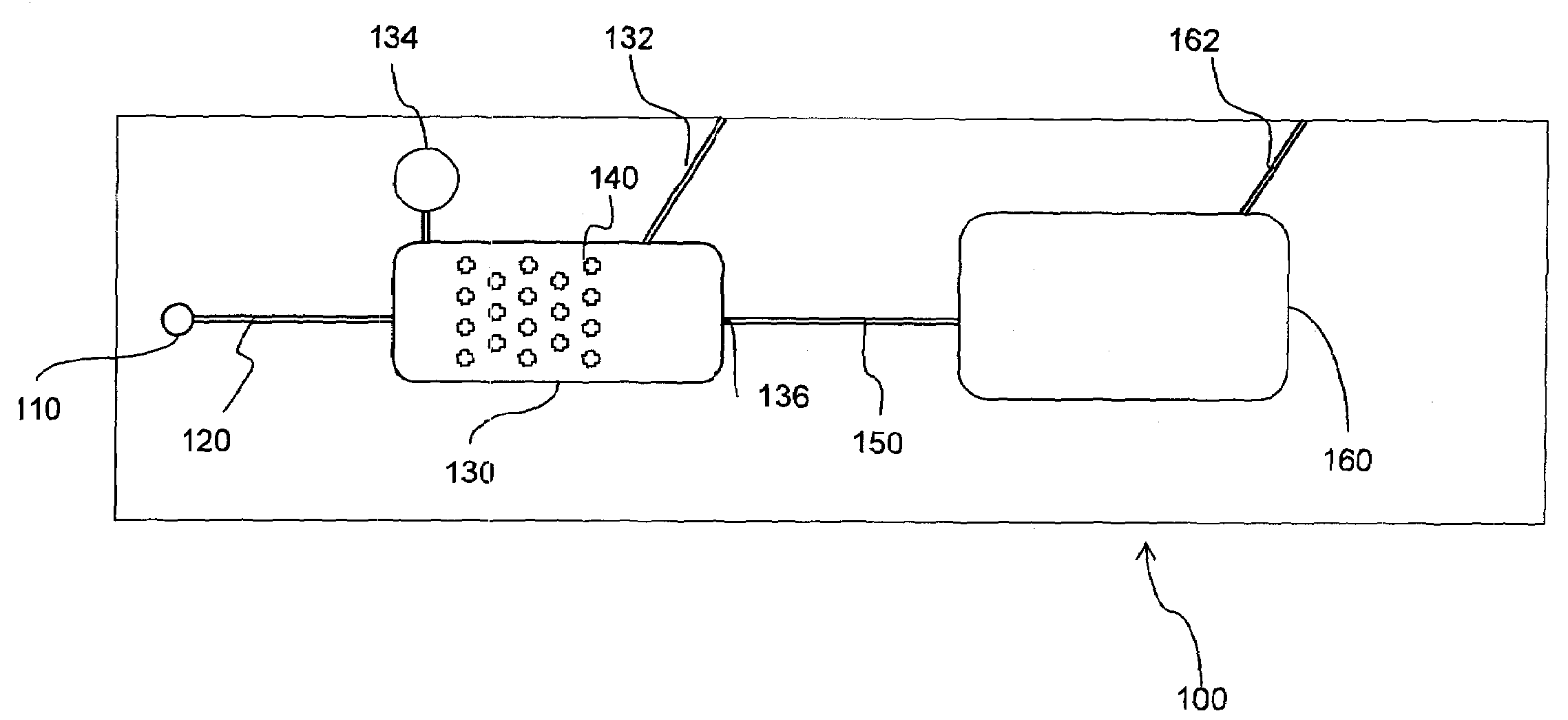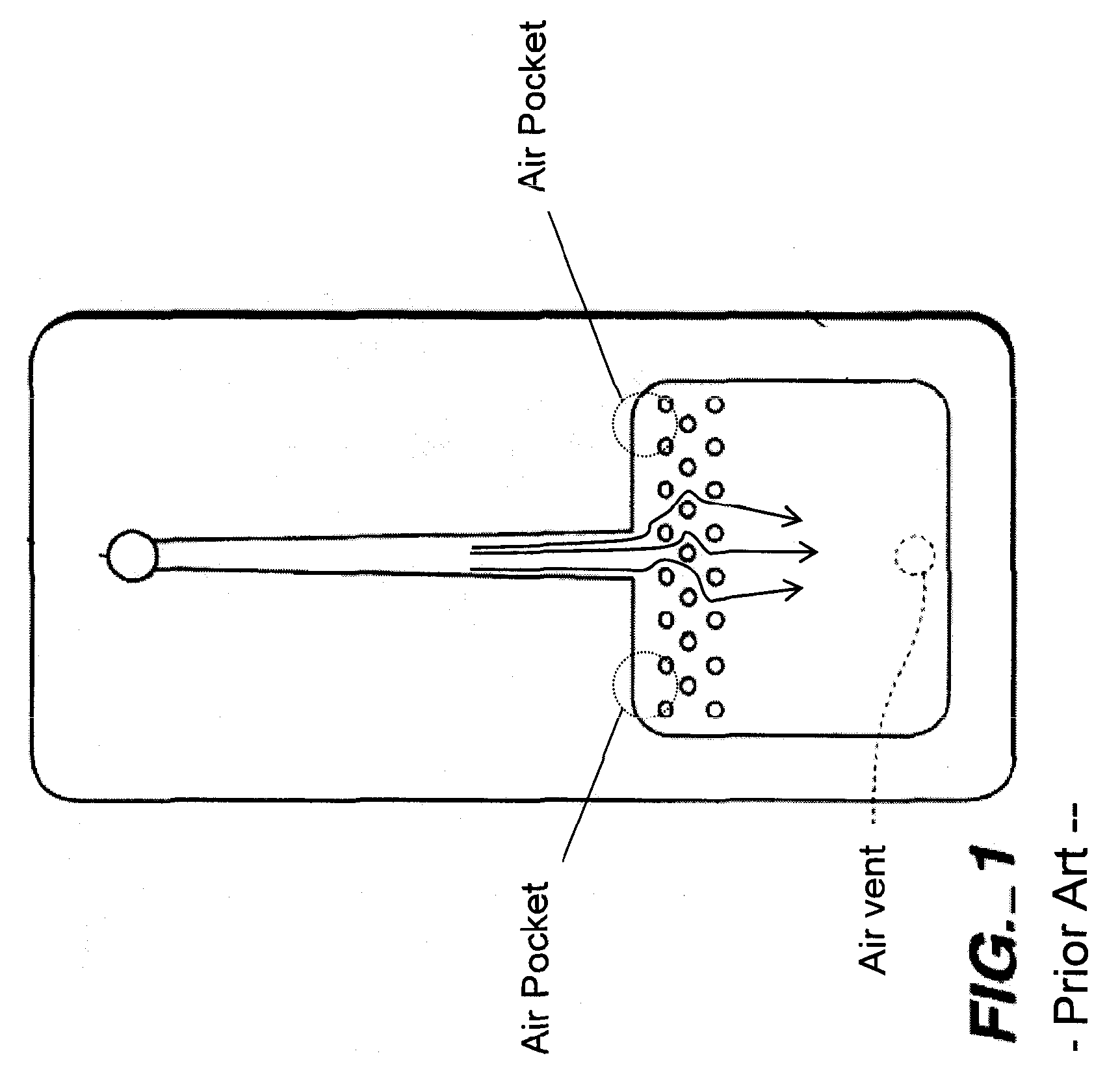Method and apparatus for entry of specimens into a microfluidic device
a microfluidic device and specimen technology, applied in the field of microfluidic devices, can solve the problems of affecting the movement of liquid and analytical, introducing difficult problems for small samples, and affecting the accuracy of liquid/fluent solid measurements, etc., to achieve accurate and repeatable assays
- Summary
- Abstract
- Description
- Claims
- Application Information
AI Technical Summary
Benefits of technology
Problems solved by technology
Method used
Image
Examples
example 1
[0054]In a test chip similar to that of FIG. 5c, the geometry of inlet port opening was varied to demonstrate that the shape of the opening was not critical to filling the inlet chamber. The results of these tests are given in the following table:
DepthWidthLengthFluidGeometrymmmmmmSampleForceFill timeRectangle0.030.1501.0WholeCapillarybloodCylinder0.1000.1001.0WholeCapillarybloodRectangle0.030.1502.0WholeCapillarybloodRectangle0.030.1502.0UrineCapillaryRectangle0.030.1502.0UrinePositivewithpressureadapterRectangle0.030.1502.0WholePositivewithbloodpressureadapterRectangle0.030.1502.0WholeNegativewithbloodpressureadapter
[0055]Using a capillary as the inlet port, the inlet chamber was filled in the less than 2 seconds with and without an adapter at the inlet. The fill time was dependent on the fluid used as well as the surface energy of the capillary and the length, width or shape of the capillary.
example 2
[0056]Using a test chip similar to that of Example 1, the pressure and volumes used to add fluid to the inlet chamber via the port opening were varied. The inlet chamber volume was 5 μL and a metering loop having a volume of 0.3 μL received liquid when the inlet chamber was filled. The experiment was performed with blood and urine.
Volume(μL)Sample delivery devicePressureObservation5Capillary without plungerTargetMetering occurs4Capillary without plungerTargetMetering occurs6Capillary without plungerTargetMetering occurs &excess overflows5Capillary with plungerHighMetering occurs4Capillary with plungerHighMetering occurs6Capillary with plungerHighMetering occurs &excess overflows5Capillary with plungerLowMetering occurs4Capillary with plungerLowMetering occurs6Capillary with plungerLowMetering occurs &excess overflows
[0057]Pressure applied either by capillary action or by use of a plunger allowed acceptable filling over a wide range of sample volumes 4-6 μL. In the case of an over fi...
example 3
[0058]The microfluidic device of FIGS. 3a-c and 4 was used to measure the glucose content of blood. Whole blood pretreated with heparin was incubated at 250° C. to degrade glucose naturally occurring in the blood sample. The blood was spiked with 0, 50, 100, 200, 400, and 600 mg / μL of glucose as assayed on the YSI glucose instrument (YSI Instruments Inc.). A glucose reagent (chromagenic glucose) reagent as described in Bell U.S. Pat. No. 5,360,595 was coated on a nylon membrane disposed on a plastic substrate. A sample of the reagent was placed in chamber 44 and the bottom of the device covered with Excel Sealplate (Excel Scientific Inc.).
[0059]Samples of blood containing one of the concentrations of glucose were introduced into inlet port 40 using a 2 μL capillary with plunger (Drummond Aqua). Since the inlet port is sealed when the sample is dispensed, a positive pressure is established which forces the sample into the inlet passageway 42 and then into the reagent area 44. The sam...
PUM
| Property | Measurement | Unit |
|---|---|---|
| Force | aaaaa | aaaaa |
| Pressure | aaaaa | aaaaa |
| Flow rate | aaaaa | aaaaa |
Abstract
Description
Claims
Application Information
 Login to View More
Login to View More - R&D
- Intellectual Property
- Life Sciences
- Materials
- Tech Scout
- Unparalleled Data Quality
- Higher Quality Content
- 60% Fewer Hallucinations
Browse by: Latest US Patents, China's latest patents, Technical Efficacy Thesaurus, Application Domain, Technology Topic, Popular Technical Reports.
© 2025 PatSnap. All rights reserved.Legal|Privacy policy|Modern Slavery Act Transparency Statement|Sitemap|About US| Contact US: help@patsnap.com



